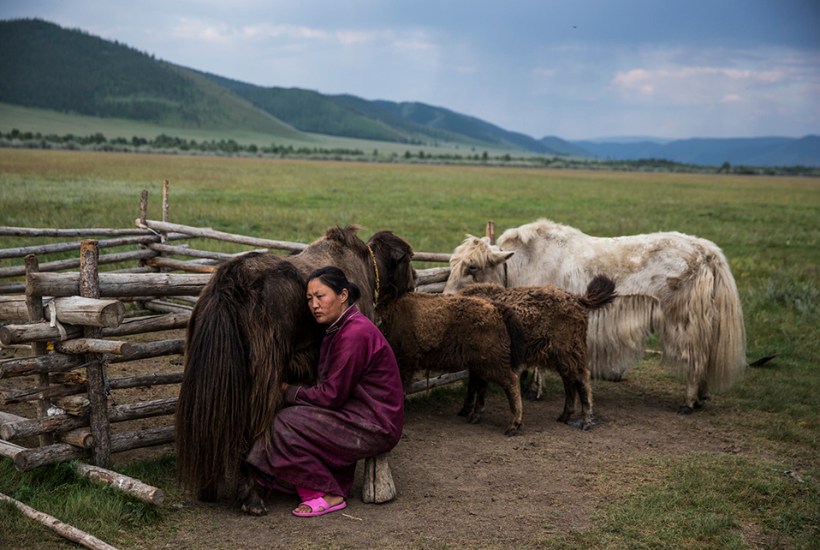The Mongolian taiga
After driving across clean, fast rivers and through forests turning golden, orange and red in the Mongolian autumn, we came upon herds of yaks grazing the taiga. The yak, or Tartary ox, is the Shetland pony of cattle, as drawn by Norman Thelwell: not much higher than a big ram at the withers, with a low-slung, fat body, an overcoat of long, shaggy hair, a woolly head and a dangling mop of a tail. The herd we alighted from our car to see was being driven down from wooded slopes by a youth riding his pony bareback, whistling and singing. As the yaks, all white and brown and black, trotted towards us, they gave out grunts reminiscent of wildebeest, but much deeper. They came close to us before they stopped in a semi-circle, grunting and snuffing the air with their wide, flared nostrils.
My Mongolian hosts, Bodio and his wife Munkhtuya, who manufacture fine clothes from yak down, brought me to the taiga to see yaks. As we approached the ger, or felt tent of their yak-herder friends, my heart lifted. Two huge dogs, shaggy black and mahogany, bounded up to greet us. Known as Bankhars, these beasts guard the herders’ livestock against wolves. At the ger to welcome us was a stout man who rejoiced in the name Sodov, with his wife and several children. Reading from my Mongolian phrasebook, I said: ‘I hope your animals are fattening nicely?’ Sodov replied: ‘Сайхан таргалж байна! – Fattening nicely!’
Sodov brought us yak clotted cream, which was delicious. Then his wife poured us yak-milk tea, into which we put gobs of cream. Around the walls of the ger sat huge bowls of yak milk. Outside it began to rain. Sodov said that aside from herding yaks, he worked as a wildlife ranger and that in these parts, wolves, deer, bears, elk, marmot and foxes were all abundant. On my last trip to Mongolia, years ago, we seemed to live off sheep’s entrails sundried on the felt beneath the eternal blue sky and washed down with silver bowls of vodka. But today Sodov produced a large pan of fat-tailed sheep mutton, carrots and potatoes that had been cooked on the stove with smooth black river stones in the pot. These scalding hot stones were taken out and juggled between hands until they began to cool. Then we all fell upon the slabs of greasy delicious meat. Afterwards we sat picking our teeth as Sodov declared that after he turned 60 he never wanted to see a yak again. He would buy a Landcruiser, he said, travel the four corners of Mongolia for ten years, then head across Asia for another ten. We relaxed there in the ger, with the rain clattering on the roof, and Sodov’s children playing rock paper scissors.
That evening, at a nearby lodge, Bodio and Sodov sang folk songs. Everybody seems to sing or play a musical instrument in Mongolia. Since my last visit 16 years ago, the place has made immense progress. People are friendly and intelligent, the place is wild, huge, full of horses and I suspect you are not going to be robbed. For much of the year you might get cold. Yaks like both the cold and the altitude, their fatty bodies and thick hair fending off winter temperatures that dive to -58°F while these beasts rootle in the snow for frozen mouthfuls of moss and grass. Before we turned in I asked Sodov if I could see the yaks being milked next morning.
I was up well before dawn, but Sodov appeared at seven thirty and we drove off back into the taiga. The grasslands were scattered with yaks, as well as herds of horses, which are milked, flocks of sheep, which are milked, and cashmere goats, which are also milked. We stopped at a camp where strapping nomadic women were milking yaks into metal buckets. Sodov said Mongolia got its yaks when the Buddhists arrived from Tibet during the imperial rule of the Mongol Khans. Originally, yaks came to Mongolia as pack animals, carrying goods from Lhasa. Sodov revealed that his name was a Tibetan one. ‘Does it mean something?’ I asked quietly. ‘It means tolerance,’ Sodov said. ‘I’m a very tolerant man.’ Yak milk is so full of goodness you can make milk wine out of it. The Tibetans make butter sculptures. Bodio and Munkhtuya make clothes for Mongolians and foreigners out of the yak, each animal yielding about a pound of down each spring. Yak down is much warmer than cashmere, but only a tiny amount of yak gets turned into stuff you can wear. Since they live in the extreme cold, yaks have no sweat glands and this is one reason they do not smell, Sodov revealed. Nearby, a yak bull grunted deeply.
Got something to add? Join the discussion and comment below.
Get 10 issues for just $10
Subscribe to The Spectator Australia today for the next 10 magazine issues, plus full online access, for just $10.
You might disagree with half of it, but you’ll enjoy reading all of it. Try your first month for free, then just $2 a week for the remainder of your first year.









Comments
Don't miss out
Join the conversation with other Spectator Australia readers. Subscribe to leave a comment.
SUBSCRIBEAlready a subscriber? Log in